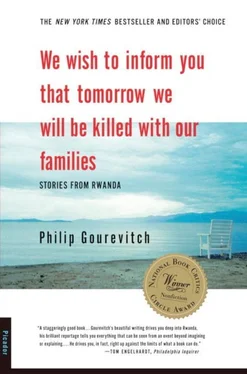At Nyarubuye, tiny skulls of children were scattered here and there, and from a nearby schoolyard the voices of their former classmates at recess carried into the church. Inside the nave, empty and grand, where a dark powder of dried blood marked one’s footprints, a single, representative corpse was left on the floor before the altar. He appeared to be crawling toward the confession booth. His feet had been chopped off, and his hands had been chopped off. This was a favorite torture for Tutsis during the genocide; the idea was to cut the tall people “down to size,” and crowds would gather to taunt, laugh, and cheer as the victim writhed to death. The bones emerged from the dead man’s cuffs like twigs, and he still had a square tuft of hair peeling from his skull, and a perfectly formed, weather-shrunken and weather-greened ear.
“Look at his feet and his hands,” said Sergeant Francis. “How he must have suffered.”
But what of his suffering? The young man in the car wreck had suffered, albeit for an instant, and the people at Kibeho had suffered. What does suffering have to do with genocide, when the idea itself is the crime?
THREE DAYS AFTER the shooting ended at Kibeho, Rwanda’s new President, Pasteur Bizimungu, a Hutu of the RPF, visited the rubble of the camp, paid his respects to a row of bodies that had been laid out for his viewing, and held a press conference, at which he announced that the official body count from the closing operation was three hundred and thirty-four. This absurdly low number suggested a cover-up, and only made the international outcry over the government’s handling of the camp closing louder. With an especially vigorous nudge from France, the European Union suspended its already limited aid program for Rwanda, and kept it suspended even after an Independent International Commission of Inquiry on the Events at Kibeho urged foreign donors to continue to support and work with the new RPF-led regime.
The Kibeho Commission was convened at the initiative of that regime, in an effort to signal that the bloody camp closing was not simply business as usual in Rwanda, and it was composed of diplomats, criminologists, jurists, and military and forensic specialists from eight countries, the UN, and the OAU, as well as a Rwandan cabinet minister. In their final report, the commissioners managed to annoy everybody involved at Kibeho—the government, the UN and the humanitarian community, and the génocidaires— by distributing blame for the catastrophe fairly evenly among all three parties.
In October of 1994, a similar Commission of Experts, set up by the UN Security Council to investigate the slaughter that had followed Habyarimana’s assassination, had found that while “both sides to the armed conflict perpetrated crimes against humanity in Rwanda,” the “concerted, planned, systematic and methodical” acts of “mass extermination perpetrated by Hutu elements against the Tutsi group” in Rwanda “constitute genocide,” and that no evidence had been found “to indicate that Tutsi elements perpetrated acts committed with intent to destroy the Hutu ethnic group as such.” That report marked the first time since the General Assembly passed the Genocide Convention in 1948 that the UN had identified an instance of the crime. So it was striking that the Kibeho Commission’s report concluded: “The tragedy of Kibeho neither resulted from a planned action by Rwandan authorities to kill a certain group of people, nor was it an accident that could not have been prevented.”
The message was clear: the Commission considered the continued existence of the Kibeho camp “an important obstacle to the country’s efforts to recover from the devastating effects of last year’s genocide,” and found that both RPA personnel and “elements among the IDPs” had subjected people in the camp to “arbitrary deprivation of life and serious bodily harm.” If this seems strangely antiseptic language for hacking unarmed children with machetes or shooting them in the back, bear in mind that human rights organizations often describe the entire Rwandan genocide as a single “major human rights violation,” which is exactly the same term these organizations use for the death penalty in the United States. The Commission noted that the RPA was a guerrilla army, inept at crowd control and police work, and in its recommendations it urged the government to develop its capacities for a humane and disciplined response to “situations of social tension and emergency.” It also found that the international humanitarian agencies, riven by political conflicts, had proved incapable of closing Kibeho peacefully, and urged them to get their own houses in order. Finally, the Commission called on the government to conduct an “investigation of individual responsibilities within its armed forces,” but it said nothing about holding the génocidaires among the IDPs to account for their crimes at Kibeho.
AROUND THE TIME that the Kibeho Commission released its report, two RPA officers who had been in command during the camp closing were arrested, and about a year later they were tried before a military court. The verdict was a telling indication of how the new regime understood its predicament. The officers were cleared of any responsibility for having presided over, or allowed, a massacre, but they were found guilty of having failed to use the military means at their disposal to protect civilians in danger, which was, of course, precisely the charge the RPF had made against UNAMIR, and the international community as a whole, during the genocide in 1994.
But from whom should the RPA have protected the IDPs if not from itself? The answer implicit in the Kibeho verdict was that the primary danger had been created by the génocidaires in the midst of the camp and by the international humanitarian organizations that had been content to let them stay there. In other words, the RPA judged itself to have taken the side of the Hutu masses against the Hutu Power leaders who had caused them so much anguish. The court was asking that the killings at Kibeho be thought of as the Norwegian nurse had suggested when I lay on the hospital floor in Butare—not as a measure of the new order, but as the ugly endgame of the old order.
Mark Frohardt, a veteran of “international emergency response” missions in Chad, Sudan, and Somalia, and the deputy chief of the UN’s Human Rights mission in Rwanda, reached a strikingly similar conclusion: “I have no intention of trying to justify the manner in which Kibeho was closed,” Frohardt said at the end of two and a half years in Rwanda. “But I do believe that it is important to understand that the inability of the relief organizations to coordinate a successful operation set the stage for the tragedy that followed. Once the army saw that the efforts of relief agencies to move people out of the camps were ineffective, they knew they were the only institution, or force, in the country capable of closing the camps.” And, he went on, “the principal reason that we failed to empty the camps and that the RPA operation turned into a disaster was… the inability to separate out those who were involved in the genocide, those who are guilty of crimes against humanity, from those who are innocent and who were not involved.”
Frohardt was speaking as a human rights and relief worker to an audience composed primarily of fellow professionals in Washington, and he saw that community’s failure at Kibeho as symptomatic of a more profound failure of its collective human and political imagination. “I have never worked in a postconflict society in which recent events, recent history, had such an unrelenting influence on the current situation,” he said. “Nor have I ever worked in a country where humanitarian and development organizations were so resistant to incorporating the cause and consequence of these events into their analysis of the current situation.” In late 1994, just six months after the genocide, Frohardt recalled, “relief workers in Rwanda were often heard making statements such as ‘Yes, the genocide happened, but it’s time to get over it and move on,’ or ‘Enough has been said about the genocide, let’s get on with rebuilding the country.’”
Читать дальше











